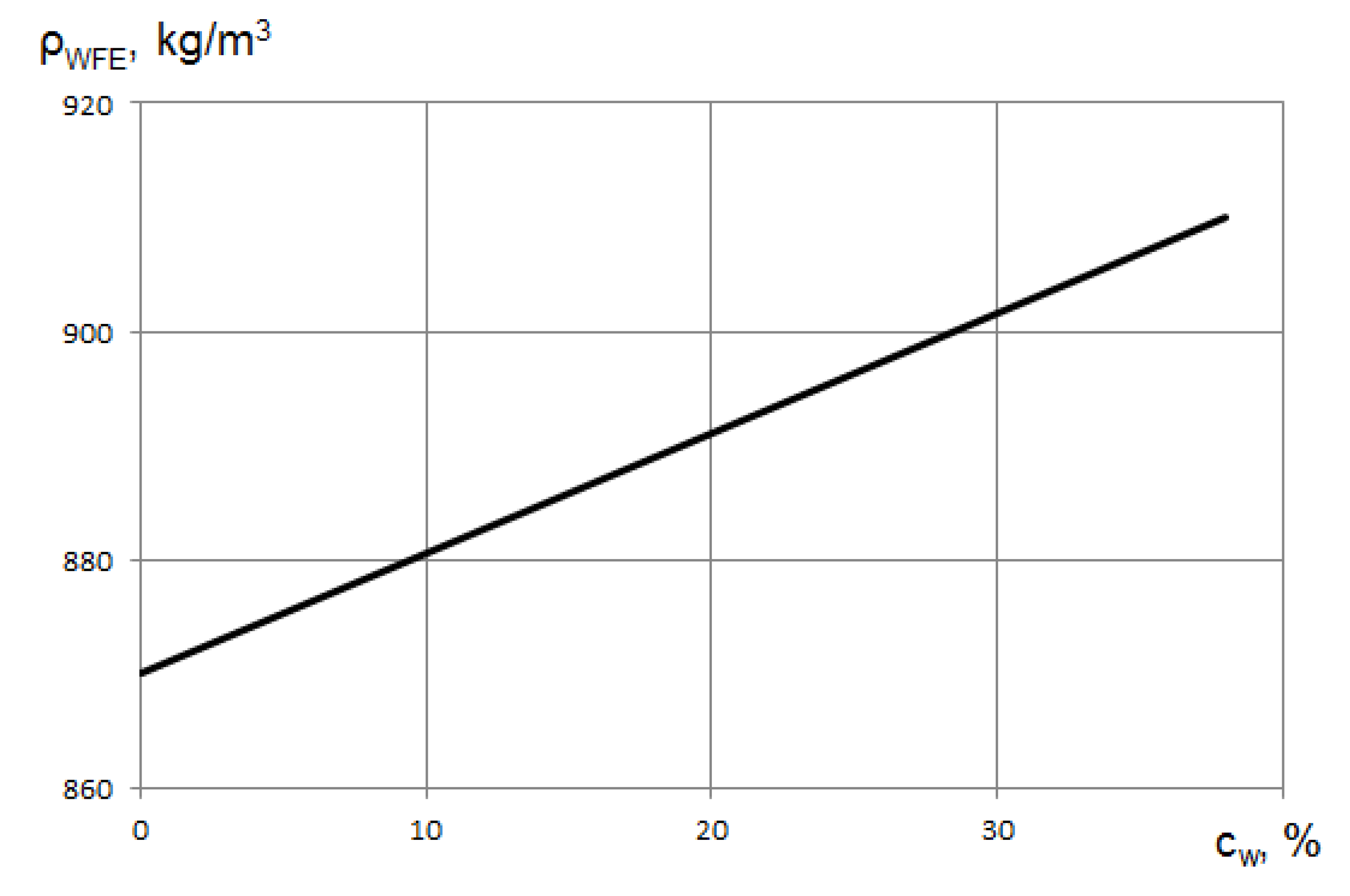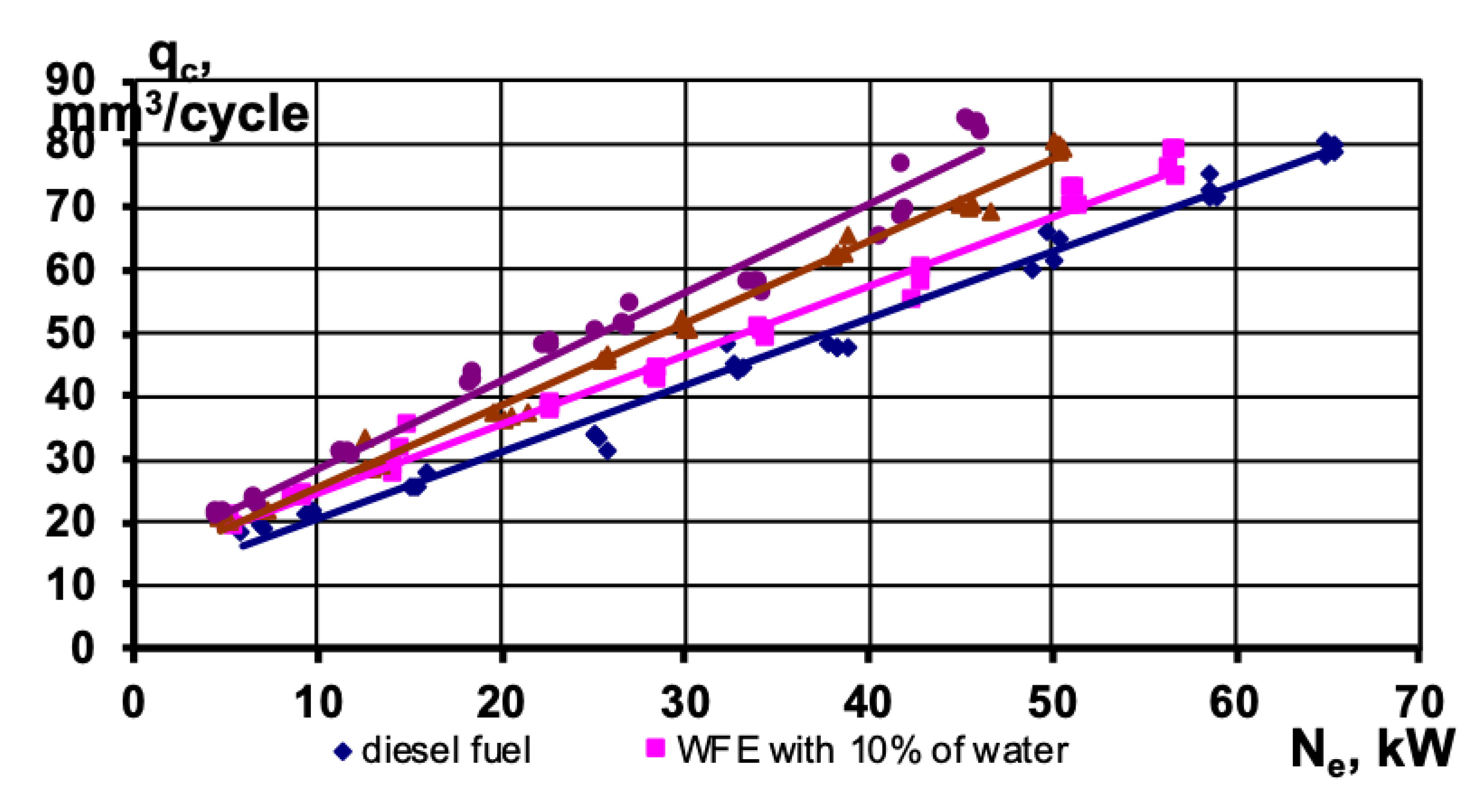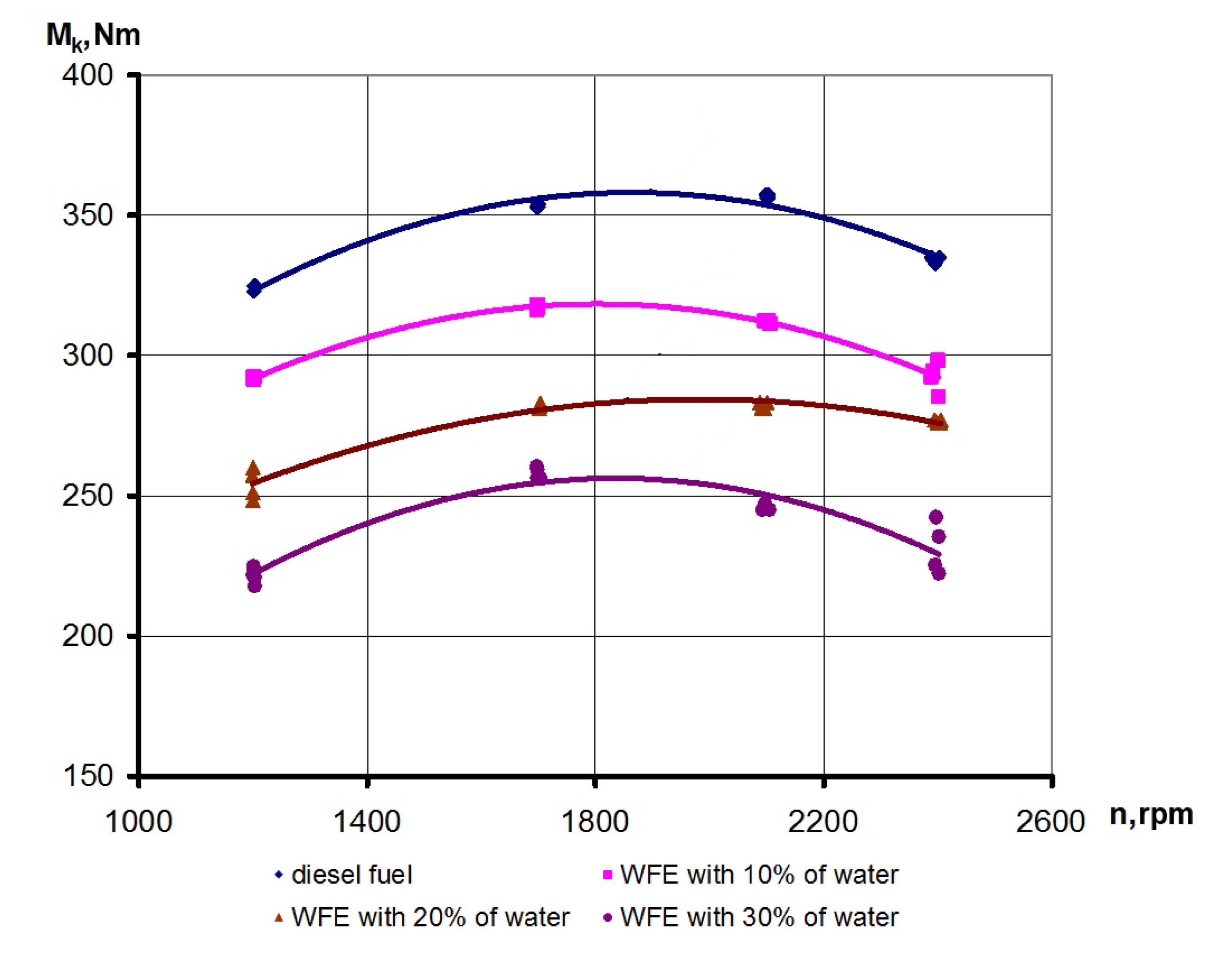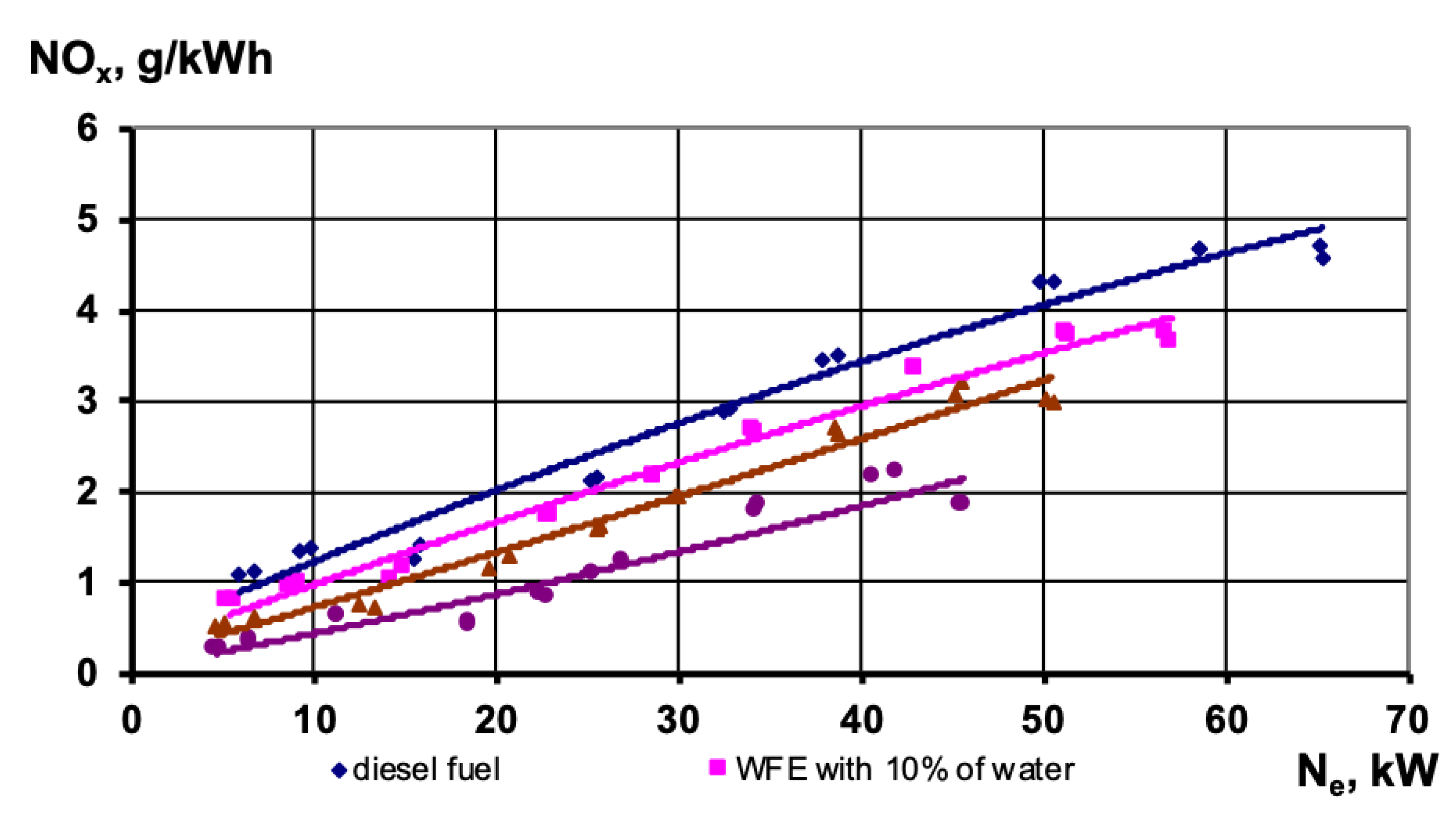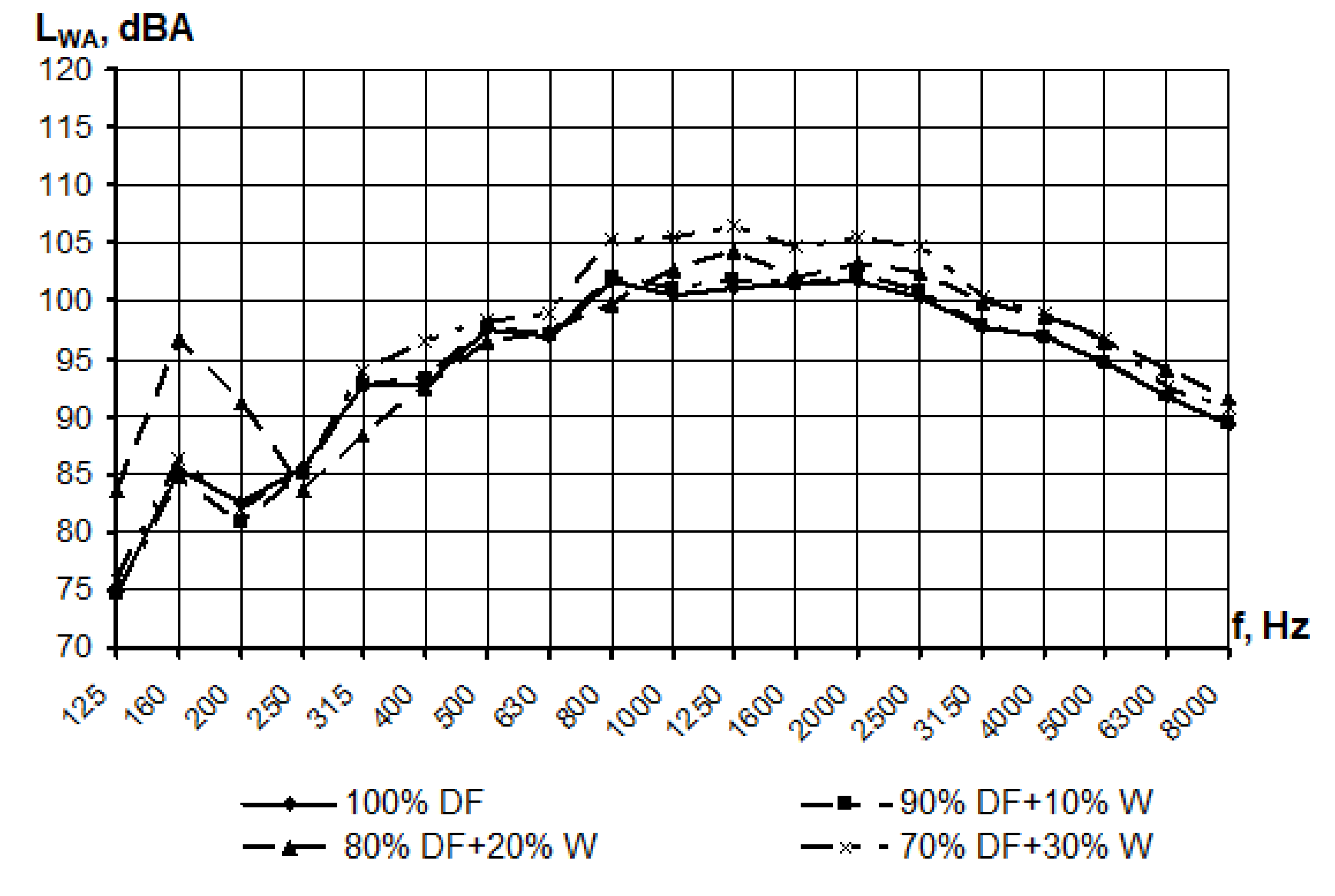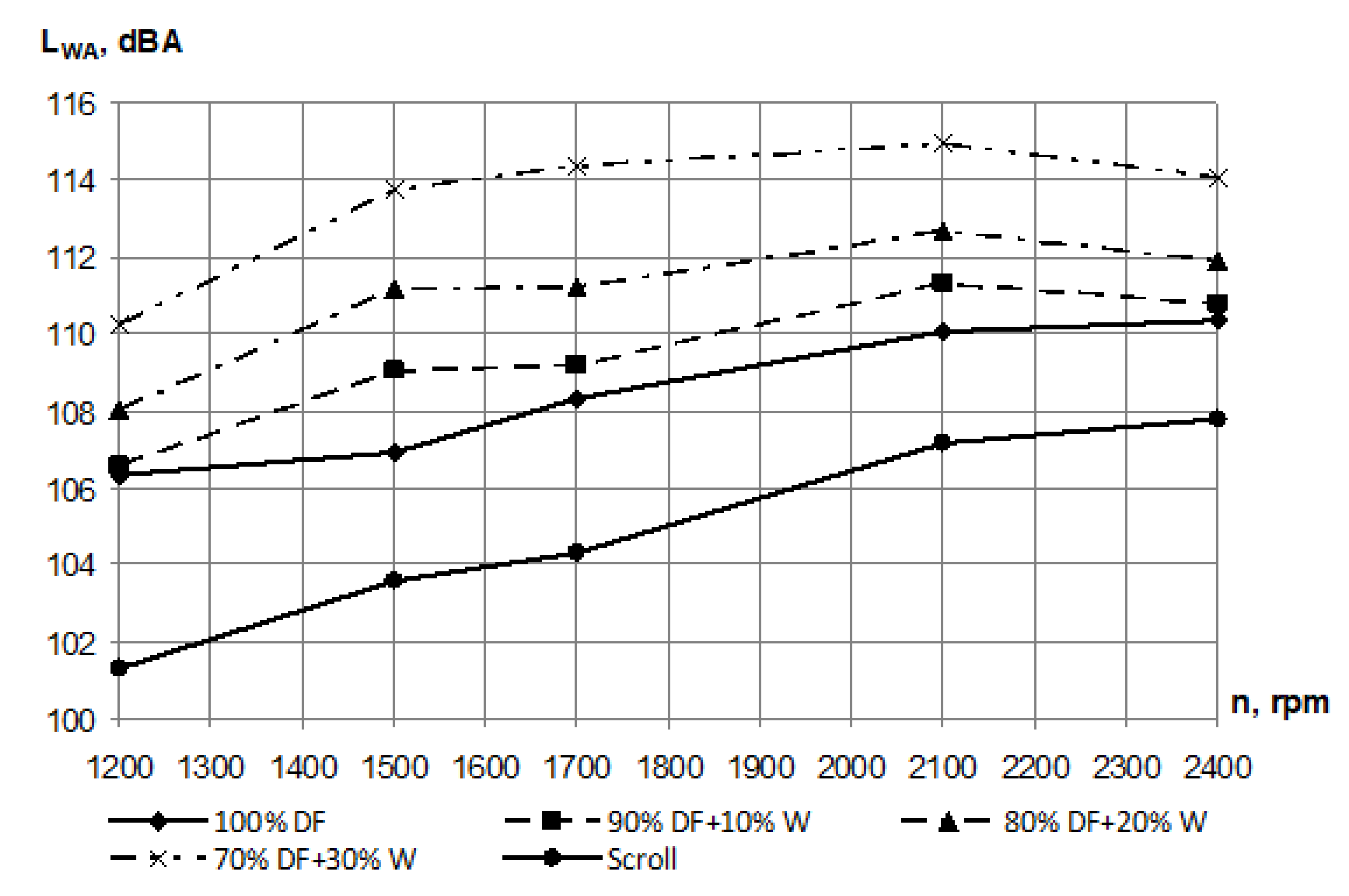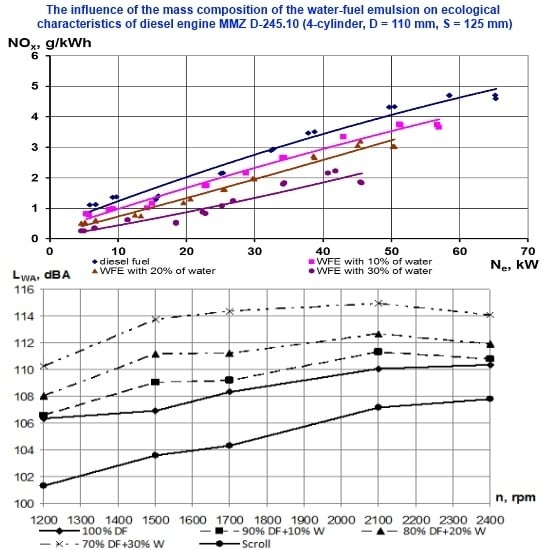1. Introduction
Water–fuel emulsions (WFE) are complex systems comprising two insoluble (one in the other) liquids, one of which (the dispersed phase) is in the form of tiny droplets (particles), and is uniformly dispersed in another liquid (dispersed environment).
The mixing of fuel with water occurs as a result of crushing the dispersed phase into small drops, and stabilization of these drops in the process of crushing in the dispersed environment.
Numerous investigations have been carried out in the field of using water-fuel emulsions (WFE) in high-speed diesel engines for transport and automotive applications. Improvement of an engine’s ecological qualities, in particular the decrease in emissions of nitrogen oxides and soot, is noted. Water in an emulsion has a negative impact on carbon monoxide and hydrocarbon emissions, which may be present in exhaust gases, including in the liquid phase [
1,
2].
Modern WFEs are complex dispersed systems with specific properties, which differ significantly from the properties of base components. Effectiveness of this system depends on the type of emulsion, its composition, and the emulsification method. The way of supplying WFE to engine cylinders has a great influence on engine operation parameters [
3,
4].
The performance of diesel engines using WFE is improved due to several circumstances. Droplets of emulsified fuel, formed after injection of a WFE into the combustion chamber of a diesel engine, consist of fuel particles that contain water particles. Due to the lower boiling point of water and its vaporization when heat is added, water particles contained in the WFE injected into the combustion chamber of a diesel engine are converted to steam in an explosive manner. This results in additional crushing and turbulent mixing of the fuel particles due to the release of water vapor from the fuel droplets. This reduces the duration of the mixing process and improves quality [
5]. In addition, injection of water-fuel emulsions into diesel engines makes it possible to reduce the compression end temperature, as well as the average and maximum cycle temperatures; this favorably affects the combustion process. The influence of mixed fuels on the structure-borne noise of the engine is also a point of interest. Combustion process severity and, as a consequence, the emitted noise, depend on the fuel used and the process organization method [
6,
7,
8,
9,
10].
In some research [
11], operation of low-speed diesel engines using WFEs with a water content from 6% to 25% are described. It has been established that specific effective fuel consumption, decreases by 3–10%, but other tests showed that it increased. The efficiency of medium-speed diesel engines has been improved by 2–5% when using WFE with a water content of 10% to 39% [
12]. For high-speed diesel engines, improving efficiency is not always possible and this depends on the mixing method. In diesel engines with a vortex chamber, it is the possible to increase the efficiency by 10–13%, but an undivided combustion chamber can provide only 5–10%. For diesel engines with a pre-chamber, the use of WFE to increase efficiency is impractical.
The results given in other works [
11,
12,
13,
14] show that the use of WFEs in low-speed diesel engines helps to reduce NOx twice, and, in high-speed diesel engines, 5–6 times. The greatest effect is achieved under partial loads. According to References [
12,
14,
15,
16,
17], the influence of WFEs on the emission of solid particles has been observed. There was a two-fold reduction in particulate emissions in exhaust gas when working on WFEs (30% water). However, a number of studies have shown that the emission of CO and polycyclic aromatic hydrocarbons increases [
14,
18].
In previous work [
19], it was assumed that one of the main reasons for the improvement of the working process of diesel, after its conversion into a WFE, is a chemical mechanism. It was established that, under the influence of high temperature, thermal dissociation of water molecules into hydrogen and hydroxyl is possible. The appearance in the flame zone of a large number of active sites of hydroxyl and hydrogen can speed up the oxidation and combustion of hydrocarbon fuels.
The ecological effects of WFE is provided by the fact that the formation of NOx and soot particles is reduced. The reduction of NOx concentrations in exhaust gas is caused by a temperature decrease in the combustion chamber; at the same time, the heat stress of the cylinder group is reduced. The presence of water vapor and hydroxyl radical provide preliminary oxidation of soot particles, which prevents their coagulation and leads to a more complete subsequent burnout.
Some physico-chemical characteristics of the water–fuel emulsion are shown in
Figure 1 and
Figure 2 [
20].
2. Methods and Equipment for the Research of Water–Fuel Emulsions
All measurements were performed on an engine mounted on a motor stand at the laboratory of the Department of “Heat Engineering and Automotive Engines” of Moscow Automobile and Road Construction State Technical University (MADI). Tests of the MMZ D-245.10 diesel engine (4-cylinder, D = 110 mm, S = 125 mm) were carried out in order to assess changes in engine operating parameters when it was fueled with WFEs having different compositions, without adapting the engine and its fuel equipment to work using emulsions. The measurements were carried out according to the methods developed on the basis of GOST 14846-91 on the stationary operation modes of the engine.
The engine was equipped with a high-pressure 4UTNI-T-1111005-50 model fuel pump (injection pump) with a plunger stroke/diameter ratio 10/10 mm and standard nozzles adjusted to an opening pressure of 21.5 MPa.
During the research, the diesel engine worked with a full load at engine speeds of 1200, 1700, and 2400 rpm. The WFE was used with a percentage of diesel fuel and water by weight: 90% and 10%; 80% and 20%; and 70% and 30%. The emulsions were prepared immediately at the inlet to the injection pump; emulsifiers were not used and did not affect the working process of the engine.
Most existing ultrasonic devices are based on the use of magnetostrictive transducers, which are characterized by a high level of energy consumption and a number of design drawbacks (for example, the need for water cooling), which complicate their use in onboard systems for the preparation of water-fuel emulsions.
We proposed a fundamentally new design for an ultrasonic emulsifying device for the production of a water–fuel emulsion. The device developed on the basis of this design is protected by a patent from the Russian Federation (RU 148368 U1).
The basis of the design of the emulsifying device is a thin-walled waveguide, in which the bending vibrations are excited. The inner cavity of the waveguide is filled with a liquid medium, which is a mixture of the emulsion components. When the vibrations of the waveguide walls are excited, a powerful ultrasonic field appears in the entire volume of the liquid, filling the waveguide, leading to the desired effect (emulsification).
The concentration of toxic substances in the exhaust gases was measured using a portable gas analyzer “Infralight-11P” and the soot content—using the smoke meter “Infralight-11D” [
5].
Engine sound pressure measurements were performed simultaneously with the measurement of the concentrations of toxic components using a method developed on the basis of GOST R 53838-2010 using microphones from PCB Piezotronics Inc. Registration and subsequent processing of the microphone signals was performed using the 8-channel measuring and processing vibroacoustic complex LMS Pimento (Belgium) in 1/3-octave bands.
3. Results of Engine Ecological Characteristics Tests
3.1. Influence of Water–Fuel Emulsion on Diesel Engine Toxic Parameters
Figure 1 and
Figure 2 show the effects of the composition of the water–fuel emulsion on the power performance of the engine. During the research, the maximum injected fuel quantity was limited by the adjustment of the fuel injection pump (
Figure 3). With an increase in the content of water in the emulsion, the maximum value of power decreased. Additionally, due to significant proportion of water in the WFE, the engine torque was reduced over the entire speed range (
Figure 4). During research, the cyclic supply of diesel fuel decreased with the addition of water.
A notable decrease in nitrogen oxide emissions was evident (
Figure 5). This was due to a decrease in the average cycle temperature. It can be assumed that the increase in the proportion of water in the emulsion degrades the combustion process of the diesel engine, so the temperature inside the cylinder decreases.
At low loads, smoke concentration of the exhaust gases (
Figure 6) varied slightly depending on the water content in the emulsion, whereas, at high loads, there was an increase in smoke concentration. For diesel fuel, a level of 0.19 m
−1 was determined at N
e = 65 kW; for the emulsion with 10% water—0.16 m
−1 at 57 kW; for the emulsion with 20% water—0.09 m
−1 at 46 kW; for the emulsion with 30% water—0.15 m
−1 at 46 kW.
3.2. Influence of Water–Fuel Emulsion on Diesel Engine Structure-Borne Noise
During the measurements, the engine was brought to a stable operating mode. Then, the signals from the microphones were recorded within 30 s. To assess the stability of the emitted noise level, three consecutive measurements were performed for each operation mode; then, the engine was switched to the next mode.
Engine noise was measured at 1200, 1500, 1700, 2100, and 2400 rpm. In addition, the measurements were made for 0, 10, 15, 25, 40, 50, 60, 75, 90, and 100% maximal torque at a constant speed. As a result, the spectra and the overall sound power levels of the engine, corrected for scale “A” (
Figure 7,
Figure 8 and
Figure 9), were obtained.
To assess the contribution of major sources of the structure-borne noise of the diesel engine in its total noise level, separation was carried out by engine motoring.
It can be seen from the spectra shown in
Figure 7 that the bulk of the acoustic radiation for all types of fuel is concentrated in the range of 630–3150 Hz.
The maximum sound power in the spectra is emitted in the 1/3-octaves range of 1000–2000 Hz, corresponding to the noise of the engine from its working process. This source of noise was the primary source for diesel engines.
According to
Figure 8, the sound power level for all the WFE compositions increased when the engine speed grew, due to an increase in the amount of energy per unit of time, which caused the engine to oscillate. The maximum sound power for all the WFEs was achieved at 2100 rpm and did not correspond to the full power mode (2400 rpm), as in case of pure diesel fuel. In this case, the lowest noise corresponded to pure diesel fuel, and the highest to the mixture of 70% diesel fuel and 30% water; that is, the noise increased when the proportion of water in the mixture grew. This can be explained by an increase in the ignition delay period at the same injection advance angle. At the same time, more fuel is supplied to the cylinder during the ignition delay period. This leads to an increase in pressure growing rate. This in turn leads to an increase in engine noise, as the speed of the vibrations of the outer surfaces of the engine increase.
As shown in
Figure 9, the maximum noise emitted by the diesel engine at an engine speed of 1700 rpm, for all types of fuels, corresponded to the range of 40%–70% of the maximum torque. A similar pattern was observed for the other engine speeds. This can be explained by the settings of the injection advance angle and the fuel supply characteristics in the engine operation modes.
For a more detailed analysis of the reasons for the structure-borne noise level changes, it is necessary to perform engine indicator tests.
4. Discussion
The influence of the mass composition of the water–fuel emulsion on the ecological characteristics of a four-cylinder diesel engine, which was not adapted for emulsion, was investigated. There was a noticeable decrease in nitrogen oxide emissions with an increase in the mass fraction of water in the WFE. This was a consequence of the reduction in the average cycle temperature.
At low loads, smoke concentrations in exhaust gases varied slightly, depending on the water quantity in the emulsion, and, at high loads, smoke concentration increased. For diesel fuel, the level of 0.19 m−1 was determined at Ne = 65 kW; for the emulsion with 10% water—0.16 m−1 at 57 kW; for the emulsion with 20% water—0.09 m−1 at 46 kW; for the emulsion with 30% water—0.15 m−1 at 46 kW.
The lowest noise level was achieved when the engine was running on diesel fuel (DF), and the highest on the emulsion consisting of 70% DF and 30% water. This can be explained by an increase in the ignition delay period at the same injection advance angle. More fuel is supplied to the cylinder during the ignition delay period. This leads to an increase in the pressure rate and in engine noise, as the speed of the vibrations of the outer surfaces of the engine increase
For all types of fuels, the highest noise level was achieved at 40%–70% of the maximum torque at a constant engine speed. This can be explained by the settings of the injection advance angle and fuel supply characteristics for these engine operation modes.
Author Contributions
Conceptualization, M.S. and A.I.; methodology, M.S. and A.I.; software, A.I.; validation, A.I., P.D. and A.D.; formal analysis, E.S.; investigation, A.D. and E.S.; resources, A.D.; data curation, A.D.; writing—original draft preparation, A.I.; writing—review and editing, M.S.
Funding
This research received no external funding.
Conflicts of Interest
The authors declare no conflicts of interest.
References
- Shatrov, M.G.; Morozov, K.A.; Alekseev, I.V.; Khachiyan, A.S.; Prishvin, S.A.; Golubkov, L.N.; Gorshkov, U.V.; Chernyak, B.Y.; Sinyavskij, V.V.; Bogdanov, S.N. Vehicle Engines, 3rd ed.; Academy: Moscow, Russia, 2013; 464p. [Google Scholar]
- Shatrov, M.G.; Alekseev, I.V.; Morozov, K.A.; Gorshkov, U.V.; Prishvin, S.A.; Sinyavskij, V.V.; Dunin, A.U.; Yakovenko, A.L.; Skorodelov, S.D. The Engines of Automobiles and Tractors; KNORUS: Moscow, Russia, 2016; 400p. [Google Scholar]
- Shatrov, M.G.; Kudryashov, B.A.; Dunin, A.U.; Eziev, A.A.; Livanskij, A.N. Improvement of performance of the diesel engine working on a water-fuel emulsion. Izvestiya Volgogradskogo Gosudarstvennogo Tekhnicheskogo Universiteta Seriya Nazemnye Transportnye Sistemy 2013, 7, 62–66. [Google Scholar]
- Mal’chuk, V.I.; Shatrov, M.G.; Dunin, A.Y. Alternative fuel supply system for diesel combustion chamber. Traktory i Sel’skohozyajstvennye Mashiny 2007, 4, 34–37. [Google Scholar]
- Shatrov, M.G.; Dunin, A.U.; Yakovenko, A.L.; Eziev, A.A. Influence of mass composition of water-fuel emulsion on environmental performance of diesel. Avtomobil’ i EHlektronika Sovremennye Tekhnologii 2013, 2, 123. [Google Scholar]
- Shatrov, M.G.; Yakovenko, A.L.; Krichevskaya, T.Y. Noise of Automobile Internal Combustion Engines; MADI: Moscow, Russia, 2014; 68p. [Google Scholar]
- Shatrov, M.G.; Sinyavski, V.V.; Dunin, A.Y.; Shishlov, I.G.; Vakulenko, A.V. Method of conversion of high- and middle-speed diesel engines into gas diesel engines. Facta Univ. Ser. Mech. Eng. 2017, 15, 383–395. [Google Scholar] [CrossRef]
- Shatrov, M.G.; Yakovenko, A.L. Method and some results of calculation of structure-borne noise of internal combustion engine for formation of components of unified information space “Internal combustion engine”. Vestnik Moskovskogo Avtomobil’no-Dorozhnogo Gosudarstvennogo Tekhnicheskogo Universiteta (MADI) 2009, 1, 10–18. [Google Scholar]
- Shatrov, M.G.; Golubkov, L.N.; Dunin, A.U.; Yakovenko, A.L.; Dushkin, P.V. Influence of high injection pressure on fuel injection performances and diesel engine working process. Therm. Sci. 2015, 19, 2245–2253. [Google Scholar] [CrossRef]
- Shatrov, M.G.; Malchuk, V.I.; Dunin, A.Y.; Shishlov, I.G.; Sinyavski, V.V. A control method of fuel distribution by combustion chamber zones and its dependence on injection conditions. Therm. Sci. 2018, 22, 1425–1434. [Google Scholar] [CrossRef]
- Thompson, R.V.; Kotsaulakos, P.S. The application of emulsified fuels in diesel engine designs: Experimental results and theoretical predictions. Trans. Inst. Mar. Eng. 1985, 97, 1–18. [Google Scholar]
- Hsu Bretrand, D. Combustion of Water in Diesel Emulsion in an experimental medium speed diesel engine. SAE Trans. 1986, 95, 285–296. [Google Scholar]
- Boeckle, S. Emulsionskersuhe on einet landsam laufendon Sulzer-Zweiant Grobdieselmotor. MasTec 1988, 47, 351–356. [Google Scholar]
- Hasannuddin, A.K.; Yahya, W.J.; Sarah, S.; Ithnin, A.M.; Syahrullail, S.; Sugeng, D.A.; Razak, I.F.A.; Abd Fatah, A.Y.; Aqma, W.S.; Rahman, A.H.A.; et al. Performance, emissions and carbon deposit characteristics of diesel engine operating on emulsion fuel. Energy 2018, 142, 496–506. [Google Scholar] [CrossRef]
- Devyanin, S.N.; Bigaev, A.V.; Markov, V.A. Influence of method of adding water to combustible mixture on diesel engine performance. IOP Conf. Ser. Mater. Sci. Eng. 2018, 327, 022024. [Google Scholar] [CrossRef]
- Savastenko, A.A.; Savastenko, E.A.; Markov, V.A.; Denisov, A.D.; Neverov, V.A. Using water-fuel emulsions in automobile and ship diesel engines. AvtoGazoZapravochnyj kompleks + Al’ternativnoe toplivo 2018, 17, 440–448. [Google Scholar]
- Khan, M.Y.; Abdul Karim, Z.A.; Hagos, F.Y.; Aziz, A.R.A.; Tan, I.M. Current Trends in Water-in-Diesel Emulsion as a Fuel. Sci. World J. 2014, 2014, 527472. [Google Scholar] [CrossRef]
- Andrews, G.E.; Bartle, K.D.; Williams, P.T. The Reduction in Diesel Particulate Emissions using Emulsified Fuels; SAE Technical Paper Series; SAE International: Warrendale, PA, USA, 1988; pp. 1–9. [Google Scholar]
- Hiroshi, O.; Hiroshi, U.; Shinzo, N. Soot formation in the Combustion of emulsion fuel-droplets. Bull. MESJ 1980, 8, 38–43. [Google Scholar]
- Markov, V.A.; Gayvoronskiy, A.I.; Grekhov, L.V.; Ivaschenko, N.A. Operation of Diesel Engines on Non-Traditional Fuels; Legion-Avtodata: Moscow, Russia, 2008; 464p. [Google Scholar]
© 2019 by the authors. Licensee MDPI, Basel, Switzerland. This article is an open access article distributed under the terms and conditions of the Creative Commons Attribution (CC BY) license (http://creativecommons.org/licenses/by/4.0/).
